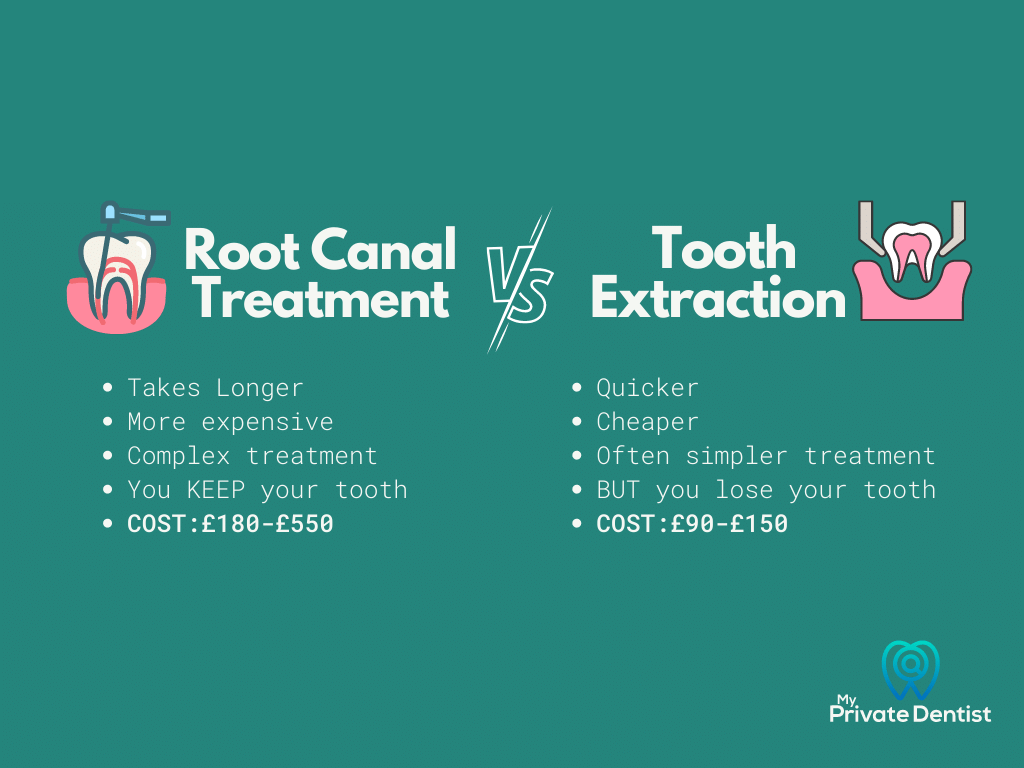Root canal vs Extraction: How do I know which to choose?
If you have been to the dentist with toothache affecting your nerve, you may be faced with the decision of whether to undergo root canal treatment or tooth extraction. It’s important to consider both options carefully. As a dentist, I regularly discuss these treatment options with my patients, and so I have written this article on root canal vs extraction to help you make an informed decision.
In short…
Deciding between root canal vs extraction? Both treatment options will relieve pain from extensive tooth decay and infection.
A dental extraction is a quicker, cheaper and often easier solution to your toothache. The disadvantage is that you lose a tooth and may have a space.
Root canal treatment takes longer, is more expensive and complex, but allows you to preserve your tooth. Keeping teeth helps you to eat more effectively and keeps your smile looking its best.

Root canal vs Extraction: How each treatment works?
Root canal treatment and extractions work to relieve common types of tooth pain including:
- A constant throbbing pain: The nerve inside a tooth dying off due to trauma or dental decay.
2. A dull ache, and pain on biting: caused by infection getting into and under your tooth.
How a tooth extraction gets rid of toothache:
Removing a tooth eliminates the nerve inside the tooth that’s causing the pain. If the tooth is infected, extraction allows any remaining infection to drain out, and the socket can heal.
How a root canal treatment gets rid of toothache:
The first stage of a root canal procedure involves accessing the nerve inside the tooth and removing it using small files. Once the nerve is removed, the infection can be drained through the tooth. Medication can also be used to kill the bacteria inside the tooth. Removing the infection relieves the pain.
It’s important to consult with your dentist to determine which treatment option is best for you as both procedures have advantages and disadvantages depending on your individual circumstances.
Root canal vs Extraction: Can a dentist help me make the decision?
When you visit a dentist for a toothache, they will assess the condition of your tooth to determine the best treatment option for you. Here are some factors that they will take into consideration:
- Tooth structure: The extent of tooth decay or damage can determine whether a root canal and restoration is possible. If the tooth is severely broken down, extraction may be the only option.
- Mobility of the tooth: if the tooth is loose, extraction may be preferred.
- Previous root canal treatment failed: If the tooth has previously had a root canal treatment but has become reinfected, extraction may be necessary.
- Crown broken off to gum level: If there isn’t enough tooth structure left to repair, extraction may be recommended.
- Root or vertical fracture:A tooth with a crack or fracture extending into the roots may not be treatable with a root canal.
- Usefulness of the tooth: You may consider extracting a wisdom tooth that isn’t functional while eating , rather than having a root canal.
What is the process of a root canal treatment?
During a root canal, the dentist will first numb the area around the tooth to ensure the treatment is painless.
Then they make a small hole in the tooth to access the pulp chamber, and use small files to remove the infected or inflamed tissue from the canals inside the tooth roots. Once the canals are cleaned and shaped, they will be filled with a material called gutta-percha and sealed with a temporary filling.
After the root canal treatment, the tooth may be restored with a filling or a crown to protect it and restore its function.
Root canal treatment is a safe and effective way to save a damaged or infected tooth and prevent the need for extraction.
Is my tooth suitable for root canal treatment?
They are several factors that increase the chance of success of root canal treatment. Treatment is likely to work in these conditions:
- The tooth has sufficient tooth structure: There should be enough tooth remaining after the root canal treatment to place a filling or crown to restore function.
- No cracks or fractures: Extensive cracks involving the roots are not suitable for a root canal.
- Adequate bone levels: The tooth should have enough surrounding bone to provide stability and support.
- Usefulness of the tooth: If removing the tooth means that you may struggle to chew on that side, you should consider trying to save it
The success rate of a root canal treatment is around 90% [1]
What are the risks of root canal?
Root canals are difficult procedures and need to be performed to a high standard. As with any procedure there are risks involved which may lead to the tooth needing to be extracted.
- Not finding all the canals: Most front teeth have one canal, but molars can have up to 4 canals. For root canal to be successful all canals need to be found and effectively cleaned.
- Blocked canals: If a canal is obstructed, the infection at the end of the root cannot be removed.
- File fracture: Dentists use small thin instruments to help clean the canals. If these break they can block the canals and prevent them being cleaned.
A root canal specialist will be needed to resolve any of the above problems. You may choose to be referred to have the problem fixed, or opt to have the tooth extracted.
When does a tooth need to be extracted?
Although a dentist will try to save a tooth if possible, a tooth may need extraction if:
- It is severely decayed or broken down. If the decay or fracture extends below the gum level the tooth cannot be restored.
- It is very loose
- It has a previous failed root canal treatment. (Although a specialist can try to carry out a re-root canal treatment.)
- The tooth is too far back to reach with small instruments for a root canal treatment
- It has a crack extending down into the roots. Although a tooth like this can be cleaned, it cannot be sealed and will become reinfected.
- If you would struggle to have a rubber dam placed, or cannot tolerate long dental procedures.

How is a tooth extracted?
The tooth and surrounding areas of the mouth are numbed up with local anaesthetic. The dentist will allow this to work for around 5-10 minutes, and then check to ensure you are unable to feel any pain.
A series of instruments are then used to gently loosen and remove the tooth. Most extractions are simple and take a few minutes, but some are more challenging and take longer. Once completed the dentist will ask you to bite on gauze to stop the bleeding. Aftercare instructions are then given.
What are the risks of tooth extraction?
All dental procedure are beneficial to the patient, but have a few risks involved. The dentist will gain your consent by explaining these to you before they start. For a tooth extraction the risks include:
- Generalised bleeding, swelling, and bruising
- Pain following the anaesthetic wearing off
- Damage to adjacent teeth
- Prolonged numbness from nerve damage (Rare) [2]
- Sinus communication (Rare) [2]
- A failed extraction. If the tooth breaks and the dentist is unable to remove all of it, you may need a referral to an oral surgery specialist for further treatment
What are the longer term effects of a tooth extraction rather than a root canal?
Although tooth extractions provide instant relief from toothache, there are some long term considerations involved with having a missing tooth. These include:
- Having multiple teeth missing may affect your ability to chew and make eating more difficult.
- There may be an unsightly gap in your smile.
- Leaving a space can cause adjacent teeth to tilt or drift.
- A missing tooth can cause the opposing tooth to over erupt. Over erupted teeth can be more difficult to clean, causing plaque and food to build up.
- When a tooth is extracted, the underlying gum and bone changes shape as it heals. The supporting bone can shrink away, which can be detrimental if you’re considering dental implants.
To maintain the position of opposing and adjacent teeth, you should consider a tooth replacement following an extraction.
When is root canal better than extraction?
Root canal treatment is a preferred treatment option for your tooth when:
- There is enough tooth structure still available
- The infection can be predictably removed
- The infected tooth is in an aesthetic zone (the teeth that can be seen when you smile)
- You are at risk of problems after tooth extraction due to medical conditions or medication.
When is extraction better than root canal?
You may choose not to have your tooth fixed, and have a dental extraction instead if:
- You would like the cheaper short term option
- You struggle with long dental treatments
- Having the tooth extracted will make no difference to your smile and how effectively you can eat e.g. an extra tooth or wisdom tooth
Medical considerations for tooth extraction
Certain medications you take increase the risks of problems after dental extraction. If you take these medications, the dentist may suggest you have a root canal treatment as opposed to tooth extraction:
- Oral or IV Bisphosphonates: Can lead to Medically Related Osteonecrosis of the Jaw (MRONJ). The bone can overgrow once the tooth is removed and the socket does not heal. Examples Alendronic Acid, Zolendronic Acid
- Anticoagulants: These ‘blood thinners’ are designed to prevent clots. When a tooth is extracted there is increased risk of prolonged bleeding. Examples Apixaban, Clopidogrel
- Chemotherapy: Healing is prolonged when undergoing cancer treatment. It may be better to wait until your chemotherapy has finished before you have a tooth removed.
IMPORTANT NOTE : You should never change your medication without consulting a doctor. If you take any of the medication above, and you need dental treatment, you should contact your doctor for advice.
Root canal vs Extraction: Which is cheaper?
A private root canal can cost between £150-£550 depending on the tooth needing treatment.
A complex case, or re-root canal treatment completed by a specialist can cost between £550. (Read more about Root Canal Cost)
An extraction costs between £90-£120.
However…
It is important to factor in the cost of a replacement tooth if you would like a new tooth in its place. For example a single tooth implant may cost you around £2500 (Tooth Implant Cost UK). Taking this into consideration, a root canal treatment may be more cost effective in the long run.
Root canal vs Extraction: Which is more painful?
Your dentist will use local anaesthetic to make either dental procedure as painless as possible. Modern local anaesthetics are very effective.
Both treatments may cause a degree of discomfort once the anaesthetic has worn off.
Post extraction pain: The pain after an extraction should subside within a few days. It can be managed with painkillers such as paracetamol, a soft diet and salt water rinses. You should avoid smoking as this can deter healing and cause a dry socket.
Post root canal pain: The pain after a root treatment is caused by the instrumentation used to clean the canals. Symptoms usually settle after a couple of days and can be managed with painkillers.
In either case, if you have prolonged pain following a procedure contact your dentist for help and advice.
Root canal vs extraction for children?
Primary Teeth: If a child has toothache from a primary tooth it may need a type of root canal called a pulpotomy. This is when the infected pulp tissue is cleaned out. The dentist may give you the option of a pulpotomy or extraction for your Childs tooth.
The decision here depends on the age of the child. If the infected tooth is due to wobble out soon, then it may as well be extracted. If the tooth is not due to come out for another couple of years, a pulpotomy may be better.
If a tooth is lost earlier than expected it can lead to other teeth moving into its place. This can lead to crowding of adult teeth when they come through.
Trauma to adult front tooth: If a child has fallen and broken a front adult tooth, extraction should be avoided. Often these teeth are complicated to root treat as the roots haven’t fully formed, and they have a wide open immature apex. These cases are best treated by a specialist.
Root canal vs Extraction: Making your decision
The article above was written to give you as much information as possible when making your decision. Ultimately it is a personal choice. A dentist will try to preserve and restore teeth if possible, as they realise the long term value in ensuring natural function.
What should I do now?
If you are experiencing tooth pain or other issues that may require extraction or root canal treatment, it is important to find a dentist to help as soon as possible.



